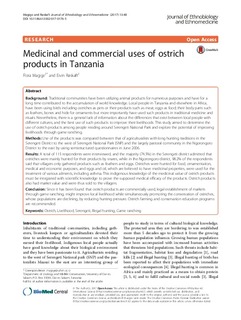| dc.description.abstract | Background
Traditional communities have been utilizing animal products for numerous purposes and have for a long time contributed to the accumulation of world knowledge. Local people in Tanzania and elsewhere in Africa, have been using birds including ostriches as pets or their products such as meat, eggs as food; their body parts such as feathers, bones and hide for ornaments but more importantly have used such products in traditional medicine and rituals. Nevertheless, there is a general lack of information about the differences that exist between local people with different cultures, and the best use of such products to improve their livelihoods. This study aimed to determine the use of ostrich products among people residing around Serengeti National Park and explore the potential of improving livelihoods through game ranching.
Methods
Use of the products was compared between that of agriculturalists with long hunting traditions in the Serengeti District to the west of Serengeti National Park (SNP) and the largely pastoral community in the Ngorongoro District to the east by using semistructured questionnaires in June 2006.
Results
A total of 115 respondents were interviewed, and the majority (74.5%) in the Serengeti district admitted that ostriches were mainly hunted for their products by snares, while in the Ngorongoro district, 98.2% of the respondents said that villagers only gathered products such as feathers and eggs. Ostriches were hunted for food, ornamentation, medical and economic purposes, and eggs and oil, which are believed to have medicinal properties, were used for the treatment of various ailments, including asthma. This indigenous knowledge of the medicinal value of ostrich products must be integrated with scientific knowledge to prove the supposed medical efficacy of the products. Ostrich products also had market value and were thus sold to the villagers.
Conclusion
Since it has been found that ostrich products are commercially used, legal establishment of markets through game ranching, might improve local livelihood while simultaneously promoting the conservation of ostriches, whose populations are declining, by reducing hunting pressure. Ostrich farming and conservation education programs are recommended. | nb_NO |

